The best varieties of edible honeysuckle
Honeysuckle is treated differently. For some it is a "wolfberry", for others it is the secret of eternal youth and longevity. Honeysuckle pulp contains vitamins A, C and E, as well as a unique complex of minerals and trace elements. If 50 years ago, honeysuckle was grown mainly in the northern regions and the middle lane, today the berry is popular in the south. Many varieties give a rich harvest and serve as a living garden hedge.
The content of the article
The best varieties of edible honeysuckle
Honeysuckle is used in folk medicine, cosmetology, and cooking. Berries are famous for their taste and health benefits.
Consider a description of the best varieties of edible honeysuckle, find out the advantages and characteristics of each.
The sweetest
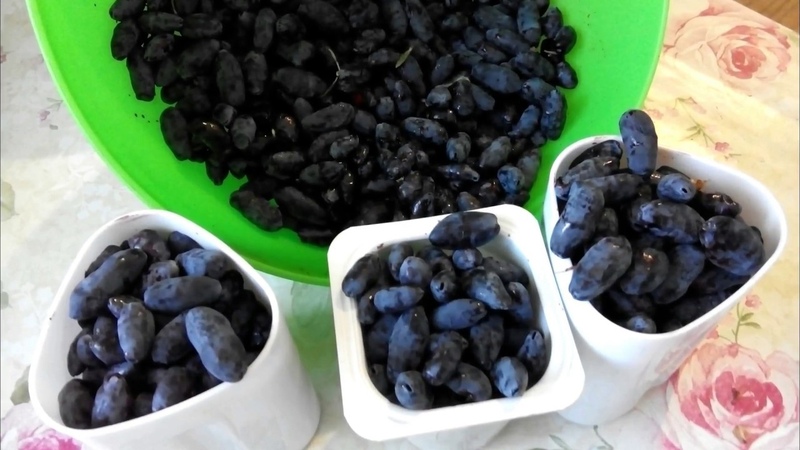
Most varieties of honeysuckle have a tart and bitter taste - for this reason, the berry is not as popular as the beloved cherries or raspberries. Therefore, when choosing a variety, they pay special attention to taste and choose the sweetest ones.
Titmouse
Tall bush, in height reaches 2 m. The crown is round, curved shoots, matte green leaves. The shape of the berry is oblong, weight is about 1 g. The taste is delicate, the flesh is pleasant to the taste, without bitterness. The skin is thin, blue-violet in color with a white bloom.
Titmouse ripens gradually, because of its thin skin, it is not suitable for industrial cultivation and trade. The yield is stable - gardeners collect about 7 kg of berries from the bush per year.
Darling
The bushes are tall with a dense crown. The leaves are medium in size, the shoots are powerful. The berry weighs 1-1.2 g, round-oval shape with a pointed end. The color is blue with a purple tint. The pulp is juicy and sweet, the aroma is rich.
Gardeners harvest about 4 kg per plant per season. Berries are used fresh or for preparing winter preparations - delicious marmalade, jam, confiture are obtained from honeysuckle.
Shahinya
The mid-late variety is distinguished by tall bushes with spreading shoots. The leaves are thick and dull, the flowers are yellow. The berry weighs about 1.2 g, the length is from 1 to 4 cm. The shape is cylindrical, the peel is of medium density with pubescence. The pulp is fragrant and juicy, without bitterness.
The yield of the Shahinya variety is about 2 kg per plant. Honeysuckle is unpretentious to soils, however, more ripe berries can be harvested on moisture-intensive loamy soils.
It is interesting:
Planting and caring for honeysuckle in the Leningrad region
Harvest
The yield of honeysuckle depends on the region of cultivation, soil condition, weather conditions, competent care. On average, one bush gives 2-4 kg per summer. But there are also more productive varieties, from which 5 kg or more are consistently harvested.
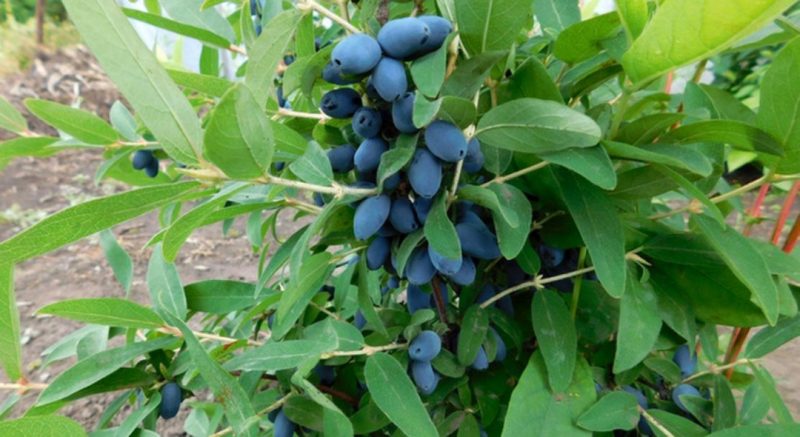
Fire opal
The unpretentious variety is suitable for cultivation in the Urals and Siberia - the plant quickly adapts to sudden changes in the weather, and is resistant to cold. The height of the bush is 1.5 m, the crown is compact. The pulp is sweet, the taste is delicate with a tart aftertaste. The fruits are violet-blue, elongated. After ripening, the berries do not crumble. The yield of the variety is about 6 kg per plant. Honeysuckle is eaten fresh or processed.
New
Bushes are compact with a spherical crown, suitable for planting in a small garden area.The ripening period begins at the end of June. The pulp is pleasant, sweet with sour notes. The berry weighs about 1 g, the shape is cylindrical-oblong. The color is dark blue, the skin is thin. Productivity 6 kg per bush. Variety Novelty is resistant to spider mites and aphids, unpretentious in care.
Siberian
The high-yielding variety is popular in central Russia and in the northern regions. Productivity 4-5 kg per bush over the summer. Fruits are even, oval, weight from 0.8 g to 1.2 g, average length 2 cm. The tree bears fruit in the second or third year after planting. The taste is sweet and sour with a pronounced berry aroma. The pulp is tender, the rind is of medium thickness.
Attention! The bitter taste of honeysuckle most often appears due to improper care - lack of watering, poor drainage, lack of mineral and organic fertilizing. Another reason for the bitter flesh lies in the wrong planting site. Honeysuckle does not take root in acidic soils.
Large-fruited
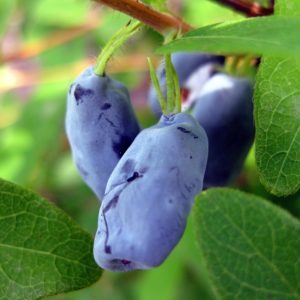
Large honeysuckle berries are good in any form - they are eaten with milk or sour cream, added to tea along with sugar, and used to make fruit and berry desserts.
In order for the fruits to grow large, it is important to follow the planting and care rules.
Bakchar's pride
One of the most popular varieties of honeysuckle in Russia. The height of the bush is about 1.6 m, the shoots are powerful, the foliage is dense. The length of the berry is up to 4 cm, weight is about 3 g. Externally, the berries resemble miniature bananas, the color is violet-blue.
The taste is sweet, not bitter... Productivity 3-4 kg per bush. Gardeners recommend paying attention to top dressing - honeysuckle reacts to a lack of minerals and vitamins.
Commonwealth
The height of the plant is up to 2 m, so it is recommended to prepare a spacious area for planting in advance. The shape of the berry is round-oval, weight is about 1.5 g. The taste is sweet with a slight bitterness, the flesh is dense. When ripe, the berries do not crack, differ in keeping quality and transportability. Harvest is used for drying, freezing, preparation of winter preparations.
Nymph
The plant is tall, up to 1.8 m in height. Fruit length up to 3 cm, weight about 2 g. The taste is juicy and sweet, the pulp is tender. The color of the berries is blue with a waxy bloom. The advantages of the Nymph variety also include resistance to fungal diseases and a stable yield - about 2 kg per plant.
Which honeysuckle to choose
Planting region is a determining factor in yield. The number of ripe berries, their shelf life, weight and appearance depend on the climatic conditions. Some varieties are ideal for weather changes and are suitable for growing in northern regions. Others bear fruit only in a warm climate.
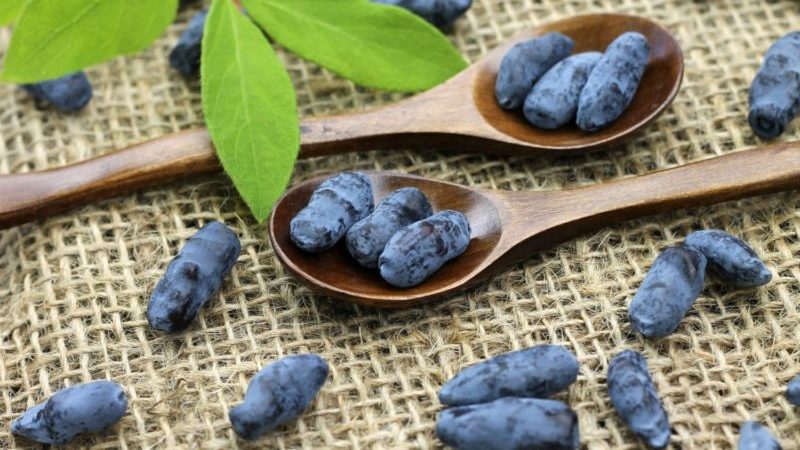
For Altai Territory and Siberia
Regions of Altai and Siberia are places with short and cool summers, frequent frosts, northerly winds and fogs. For planting, choose frost-resistant varieties with immunity to viral and fungal diseases.
Kingfisher
The height of the bush is up to 2 m, the crown is compact, the shoots grow straight. The plant has an attractive appearance, which is why gardeners often use Kingfisher as a hedge. The berries are pear-shaped, weight is about 1 g. The taste is pleasant, the sweetness is moderate. Productivity from 2 to 4 kg per bush.
Thanks to the thick skin, the berries tolerate transportation well. The kingfisher is resistant to powdery mildew and rot, and is rarely affected by aphids and other insects.
My joy
The mid-late variety is grown in places where the sun appears rarely and for a short time. The shrubs are neat, they will decorate any garden plot. Berry weight from 0.7 g to 1 g. The shape is oval oblong, color is blue with a waxy bloom.
From 2 to 3 kg of the crop are harvested from the bush, used fresh and for sale. Sweets and desserts are prepared from Joy - marshmallow, marmalade, jelly.
Cinderella
Bush height up to 0.7 m, sprawling shoots. The shape of the fruit is elongated, pointed towards the tip. Average berry weight 1 g, rind with a waxy bloom, deep blue color. The taste is refreshing, sweet and sour, the pulp is juicy and aromatic.
The fruiting period occurs in mid or late June. If it is a cool summer with rains, then Cinderella matures gradually. Productivity 3 kg per bush.
For the middle lane and the Moscow region
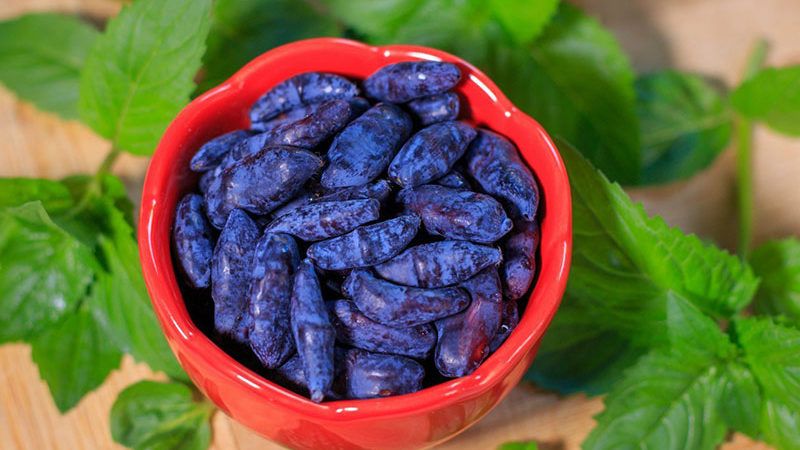
Honeysuckle for cultivation in the middle lane and the Moscow region should be drought-resistant. It is recommended to choose berries that do not crack in the absence of moisture for a long time, retain their useful, marketable and taste qualities.
Blue bird
A universal variety is grown on nutritious and loose soil. The height of the bush is about 1.5 m, the shoots are thin, the crown is dense, spreading. The length of the berry is up to 2 m, weight is about 1 g. The peel is thin, covered with a waxy coating. The color is blue-violet, matte. The honeysuckle Blue bird tastes like wild blueberries - the pulp is sweet and sour, the taste is tart. The yield is from 2 to 4 kg, depending on weather conditions and compliance with agrotechnical rules.
Amphora
The height of the mid-late honeysuckle bush is about 1.5 m. The round and compact crown looks attractive in the garden. Fruit length 2 cm, weight 2-3 g. The surface is smooth, the skin color is blue-violet, there is a strong waxy coating. The taste is sweet and sour, notes of wild berries are felt. The crop is transportable, suitable for making juices and compotes.
Silginka
The variety manifests itself as high-yielding, frost-resistant and unpretentious. Suitable for growing in the middle lane, especially in regions with frost and unstable climate. The berries are large, the weight of one is from 1 g to 1.5. The taste is fresh and sweet, without bitterness. The color of the fruits is violet-blue with a waxy bloom. The skin is thin, the aroma is berry, pleasant.
The berries ripen together, they do not stick tightly to the branches and do not crumble. The yield of one bush varies from 1.5 kg to 3 kg.
Pauline
A fast growing and unpretentious variety that is gaining popularity. The berries are large, without bitterness. The variety is rarely sick, frost-resistant. The harvest is appreciated for its taste and attractive commercial qualities.
For the Leningrad region and the North-West
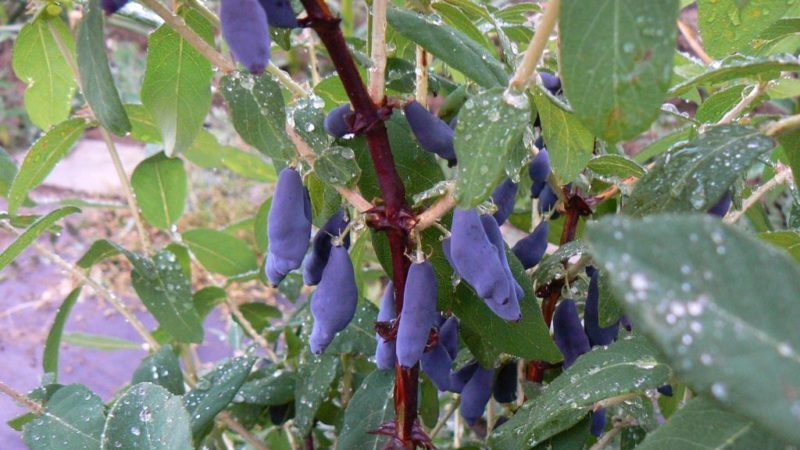
The bushes of the Leningrad selection are compact in size and squat, gardeners often use honeysuckle to create a hedge. For planting, varieties are chosen that are resistant to high humidity, sudden temperature changes and infectious diseases.
Omega
Bush height up to 1.5 m, compact crown, medium-sized shoots. The berries are oval, deep blue, with a light waxy bloom. The skin is thick, so the fruits do not deteriorate for a long time, are suitable for transportation and are kept well. The average weight of a berry is 1 g. The Omega variety is frost-resistant, rarely sick, grown on private garden plots and on an industrial scale.
Blue spindle
Early ripe variety bred in Siberia, but also suitable for growing in the North-West of the country. Resistant to high humidity, does not have any special requirements for maintenance. The length of the berry is up to 3 cm, weight is about 1 g. The surface is slightly tuberous, color is blue-violet. The skin is dense, the pulp is sweet and sour, with a pleasant unobtrusive aroma. It is recommended to use berries for processing, they make a tart and tasty jam or jam.
Violet
The mid-early Violet variety is famous for its beautiful compact bushes and large berries. The weight of one is about 1.5 g, some fruits reach 2 g. The surface is bumpy, the skin is dense, blue with a waxy bloom. The pulp is sweet and sour, not bitter. The berries are universal in use, do not crumble, retain their elasticity and taste even after harvest. One bush gives about 2.5 kg of fruit per summer.
Interesting! Without honeysuckle, it is impossible to cook the national dish of Hungary - retesh. It is a pie filled with honeysuckle, apricots, honey, butter and starch. An original dish for those who want to please their loved ones with a delicious and healthy dessert.
For the Urals

The weather in the Urals is unpredictable. Summer can be hot, foggy, heavy rains and even frost and snow.It is important to choose a frost and drought tolerant variety with a stable yield.
Enchantress
Mid-season variety takes root on loamy and sandy loam soils. The height of the bush is up to 1.5 m, the crown is spherical. The average berry weight is 1.6 g, pear-shaped, blue color, gray bloom. The pulp is fleshy, the taste is delicate and sweet, with a slight sourness. Productivity from 2 to 3 kg per plant. The Sorceress bears fruit stably, the berries are firm. The sorceress is resistant to rodents and insects.
Zest
Bushes are medium-sized with curved shoots. The berries are large and oblong, the weight of one reaches 1.5 g. The ripening period is early, the yield is 1-2 kg per bush. The skin is dense and bumpy, the pulp is fibrous, sweet. Variety Raisin is a frost-resistant variety, however, for growing large berries, systematic mineral fertilizing is required. Due to its dessert taste, Zest is eaten straight from the bush. For longer storage, the honeysuckle is ground with sugar.
Bazhovskaya
The bush is spreading and wide-growing, requires a lot of space. The berries are dark blue, round in shape, externally, the fruits look like small barrels. The average weight of a berry is about 1 g. The pulp is very pleasant and sweet, without bitterness. Productivity up to 2 kg per bush. The berries are prone to shedding, so they are harvested 2-3 times per season. The purpose of the variety is universal.
Conclusion
For the use of honeysuckle in cooking, it is recommended to plant sweet and juicy varieties without bitterness - Chosen One, Pride of Bakchar, Nymph. The berries of these crops are fragrant, with tender pulp. For long-term storage, gardeners grow varieties with dense peel and waxy bloom - Omega, Violet, Magician.
Honeysuckle is planted in bright and spacious areas, away from other fruit and berry plants. Harvested as it ripens, gloves are used during harvesting so as not to erase the wax coating. It is thanks to him that the fruits are stored for a long time and do not lose their beneficial properties.